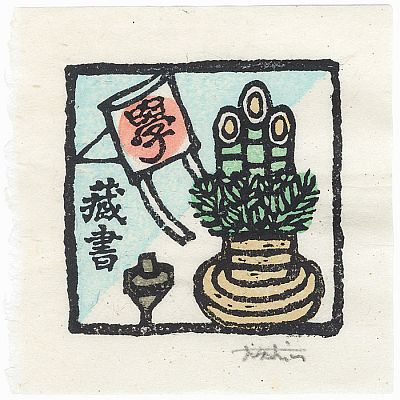| |
Unknown
|
|

Ex Libris
(蔵書)
1940 ~ 1960
Comment - Ex Libris (Zōsho-hyō, 蔵書票) are book plates pasted onto the front or the inner cover of books to indicate ownership (ex libris, Latin for "from the library of"). Zōsho-hyō (Ex Libris) became known in Japan by the Prague-born painter Emil Orrick in 1900 (Meiji 33) in the literary magazine "Myōjō" (Morning Star, 明星) . Painters and printmakers have begun to handle print-style ex libris stamps. Among the famous artists, Yumeji Takehisa , Shiko Munakata , Takeo Takei, etc. are working on Ex Libris. The "Japan Book Plate Association" (Nihon-sho-hyō kyōkai, 日本書票協会) was established in 1922 and is still the center of research and collection.
Zōsho-hyō (Ex Libris) have also been made by a variety of famous sosaku hanga artists, including Azechi Umetaro, Hiratsuka Unichi, and Kawakami Sumio, many of them organized in the the "Nippon Exlibris Association" (Nihon-sho-hyō kyōkai, 日本書票協会), founded in 1943. the "Nippon Exlibris Association" actively promotes this genre of miniature woodblock prints, publishing newsletters and an annual calendar featuring works by its members. A fun and unusual collectible, rarely seen outside Japan.
This Zōsho-hyō (Ex Libris, book plate) shows a
typical "Kanji kite" ("ji tako", "字凧" with a Japanese flag design showing
the kanji character "Gaku"
(學), meaning 'scholarship', 'learning' or 'knowledge'. If it's
a name, depending on the 'reading',
it may be pronounced 'Satoru', 'Manobu' or 'Makoto', maybe the
name of the book owner. The kite is an Edo Kaku (江戸角), the small
brother of an Edo Kite.
The arrangement with a typical kadomatsu decoration and
the spinning top on the lower left, hints at New Years
festivities.
Series
- none
Artist - unknown shin hanga artist (not read)
Signature - pencil signature (not read)
Publisher - unknown
Image Size - 6.1 X 6.1 cm (2 3/8" x 2 3/8") + margins as shown
Condition - single sheet; nishiki-e (cloured woodblock);
Artist - unknown shin hanga artist (not read)
Signature - pencil signature (not read)
Publisher - unknown
Image Size - 6.1 X 6.1 cm (2 3/8" x 2 3/8") + margins as shown
Condition - single sheet; nishiki-e (cloured woodblock);
zurueck zur Hauptseite / back
to main page
Copyright 2008 ff: Hans P. Boehme